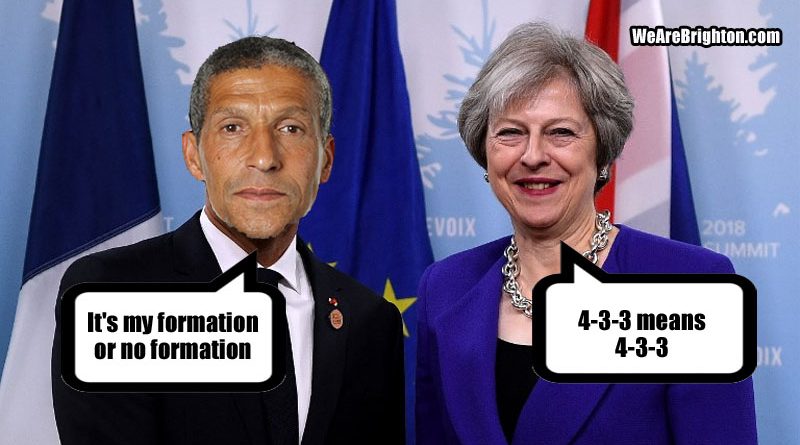The numbers that show that Hughton has to ditch his 4-3-3
Formation, formation, formation. It seems that every single person who watches Brighton on a regular basis can see that Chris Hughton’s change to a 4-3-3 formation is the major reason behind the Albion’s alarming collapse in form – except the one man who matters.
Hughton is clearly a clever man. He wouldn’t have led us to the Premier League and kept us there without being an excellent manager. Which begs the question, how can he not see that since he moved away from the 4-4-1-1 shape that proved so successful last season in favour of a 4-3-3, we’ve been terrible?
We wrote extensively about the problems with playing 4-3-3 as long ago as the start of February. To summarise, it leaves the full backs hopelessly exposed, it had significantly weakened us defensively, it doesn’t play to the strengths of our most creative player (Pascal Gross) or our best striker (Glenn Murray), it narrows the pitch so that we have less options to pass to going forward and we don’t have a specialist defensive midfielder to make the system work.
Yet here we are, four months into the 4-3-3 era and with just eight points from a possible 36 since the turn of the year and yet Hughton is still persevering it. He’s beginning to look like Theresa May, continuing to push a bad idea out of either delusion or stubbornness. 4-3-3 means 4-3-3. It’s my formation or no formation.
To analyse just what a disaster the move to 4-3-3 has been, we’ve decided to compare the first 13 games of the season in which we played 4-4-1-1 with what has happened in the subsequent 19 matches since the new formation was first adopted away at Huddersfield Town in early December.
It doesn’t make for pretty reading.
Average points per game playing 4-4-1-1 compared to 4-3-3: 1.15 v 0.62
15 points from 13 matches in the first half of the season playing 4-4-1-1 at an average of 1.15 per game had the Albion on course for survival. At that rate, we’d have hit 43 by the end of the campaign, which would have been three points more than in 2017-18. Undeniable progress. Since adopting 4-3-3, that average drops to 0.62. Over the course of a 38 game Premier League season playing 4-3-3, we would accumulate just 23 points, which would have seen us relegated to the Championship this season seeing as Cardiff City have already gained 28. If Brighton stay up and Hughton persists with his new formation next year with the same dire results, we’ll be nailed on to go down.
Goals scored per game: 1.07 v 0.94
One of the main arguments behind the change in formation was that 4-3-3 would supposedly make us more attacking. There were plenty of supporters calling for it after we’d “only” won three games in a row 1-0 against West Ham United, Newcastle United and Wolverhampton Wanderers. The theory went that by pushing the wingers up higher in support of the lone striker, we’d become more of a threat going forward. The opposite has proven to be true with our goals-per-game ratio since the change dropping from 1.07 to 0.94. Whilst it is true that Gross and Jose Izquierdo, both regulars in the scoring and assisting charts last season have missed large parts of the campaign, the main issue seems to stem from the fact that without two out-and-out wingers, the Albion can’t deliver the early crosses and balls into the box on which Murray thrives on. Hughton’s new shape blunts our only regular goal scorer.
Goals conceded per game: 1.46 v 2.40
Not only has 4-3-3 resulted in us scoring less, but it’s also led to us conceding far more – nearly one extra goal per game to be precise. The Albion’s survival last season was built on defensive solidity. Two banks of four which were devilishly difficult to break down gave us the eighth best defensive record in the division. Although we weren’t quite as good in the first 13 games of the season, 4-4-1-1 was still only averaging 1.46 goals against per game. With 4-3-3, that jumps up to 2.40. For a side who struggle to score at the best of times, you cannot afford to concede over two goals a game and expect to win. With the defence no longer protected by four men stationed in front of them, we look leakier than Julian Assange.
Our home form has collapsed
The statistics offer pretty damning evidence of how 4-3-3 has completely torn up the blueprint to success from last season and the first 13 games of this campaign. But they only tell part of the story. The most alarming difference that 4-3-3 has made is that it has completely destroyed the concept of the Amex as a fortress. In 25 home games across the 2017-18 season and the start of this, the Albion only lost to one side outside of the big six – Leicester City in March 2018. Since ditching 4-4-1-1, Burnley, Southampton and Bournemouth have all triumphed in Sussex scoring nine goals between them with Brighton managing just one. Home form was the bedrock of Brighton’s Premier League survival but playing 4-3-3 has completely destroyed it.
Conclusion
Playing 4-3-3, the Albion average half a point less per game than when using 4-4-1-1. They score under a goal a game with the new formation, concede nearly two-and-a-half per fixture and have been picked off by three sides that you cannot afford to drop points to at home, when previously only one opponent outside the top six had won at the Amex. The case against 4-3-3 is pretty damning. We can only hope that Hughton admits he has got this wrong and gets rid of a formation that quite plainly isn’t working. If he doesn’t, then we could pay with our place in the Premier League and – whisper it quietly – he could end up paying with his job.
It’s time to ditch 4-3-3, Chris. We can all see it. Why can’t you?




